Refining our customer’s value story
March 25, 2021
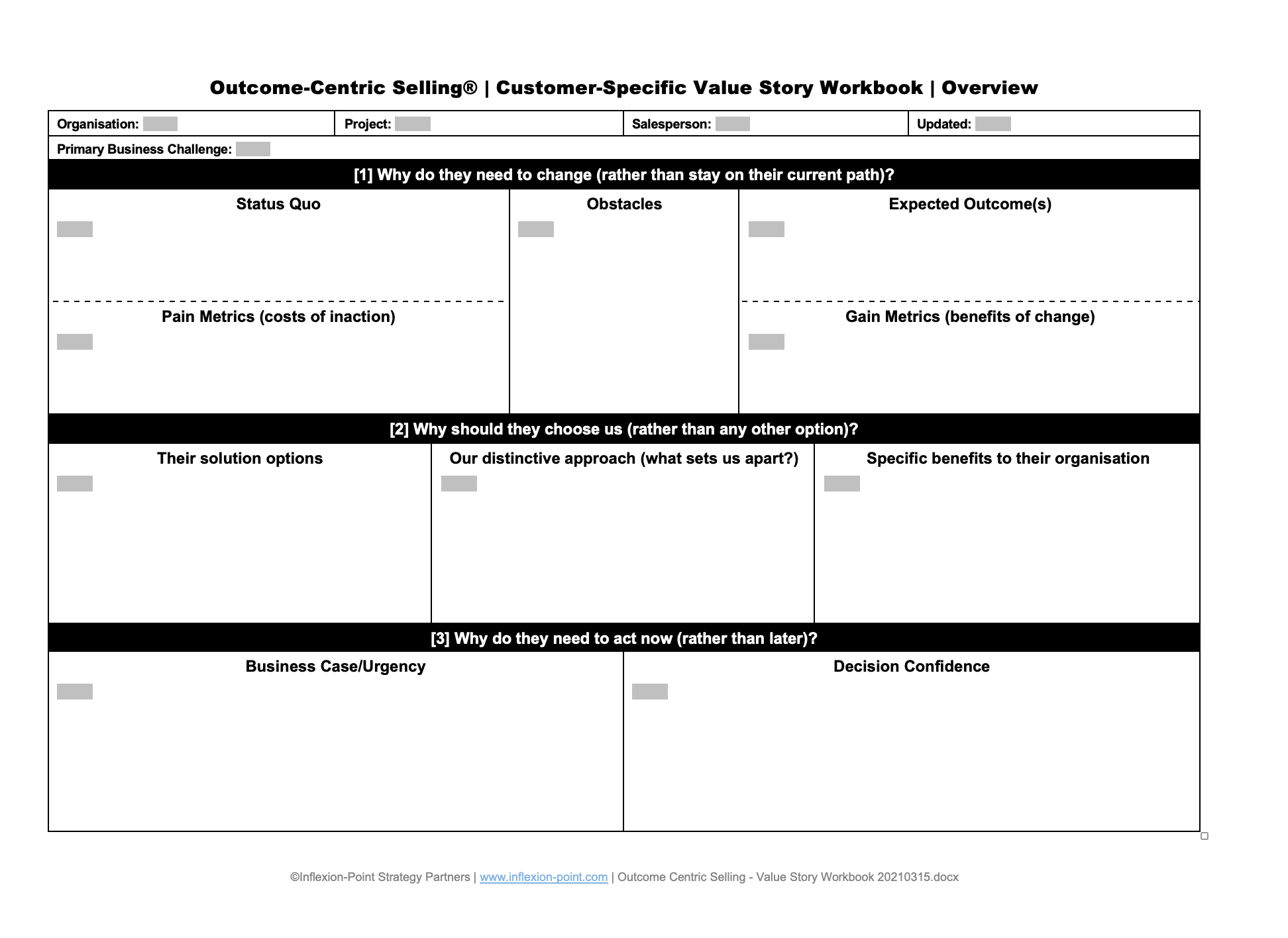
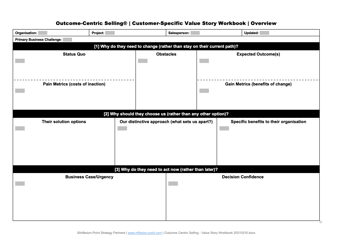 Regular readers will know that I have been evangelising the critical importance of customer-specific value stories for a long time. I’d like to take this opportunity to update you on my latest story framework, fuelled by a growing number of client projects in complex B2B sales environments.
Regular readers will know that I have been evangelising the critical importance of customer-specific value stories for a long time. I’d like to take this opportunity to update you on my latest story framework, fuelled by a growing number of client projects in complex B2B sales environments.
Let me start by explaining what I mean by a “customer-specific value story”. Unlike value propositions generally, which tend to be targeted at broad audiences rather than specific organisations, a customer-specific value story is unique to each prospective customer.
Because of this, no two customer value stories are ever exactly the same, even if those crafted for similar organisations who are facing similar issues will often exhibit similar overall themes. But they all benefit from following a similar framework...
Your customer’s four critical questions
Any customer embarking on a significant buying decision will want to satisfy four key questions before they are ready to move forward. If any of the answers are weak, incomplete or unsatisfactory, they will be unlikely to want to advance.
This has become even more important in an uncertain business environment - they need to be convinced of the need for change, and to be confident that the investment and effort involved will be worth it.
Here are the four key questions:
- Why do we need to change (rather than stay on our current path)?
- Why should they choose you (rather than any other option)?
- Why do they need to act now (rather than later)?
- Who will benefit from the change (and how)?
If the all-important executive summary of your proposal does not address all four questions, your chances of winning are significantly reduced. And yet I still come across many sales proposals that focus almost exclusively on the “why us” question and fail to do justice to the customer’s other concerns.
This is particularly important when it comes to discretionary purchase decisions - situations where the customer is not actually obliged to buy something but could decide after months of deliberation to stick with the status quo, at least for a while. It's the primary reason why losing to no decision than to another competitor is the most common outcome under such circumstances.
Page one of the value framework deals with the first three questions:
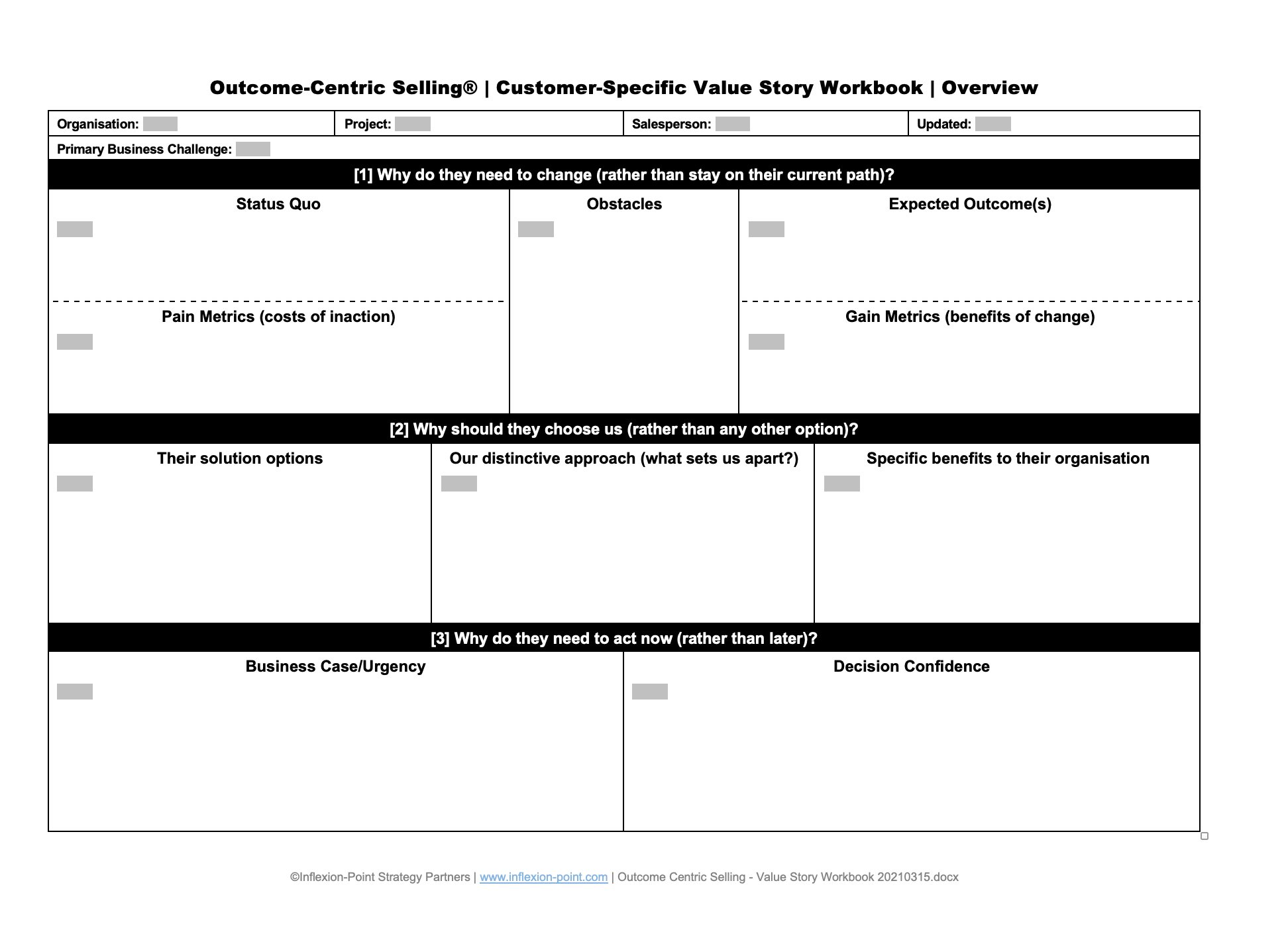
[1] Why do we need to change (rather than stay on our current path)?
The key idea here is to establish the strongest possible contrast (and the widest possible outcome gap) between perpetuating the customer’s status quo and their desired business outcome and there are five related elements that we need to master to craft a compelling “why change” message:
Status Quo
We need to explore and briefly summarise our potential customer’s current situation/direction and where they are likely to end up if they continue on their current path, specifically highlighting the business problems, risks and opportunities (things they need to fix, avoid or accomplish) that we are particularly expert in dealing with.
Pain Metrics (costs of inaction)
We then need to uncover, develop and highlight the pain-related business metrics associated with their current situation/direction (such as increased cost, delay and/or risk, loss of revenue, reductions in productivity and/or customer satisfaction, and so on), and project how these impacts are likely to get worse if nothing changes.
Expected Outcome(s)
Next, we need to understand, influence and summarise the different/better future outcome(s) our customer is seeking, placing a similar emphasis on the results that our organisation is particularly good at addressing. If possible, we need to make a clear connection with the prospective customer’s top-level corporate priorities and initiatives.
Gain Metrics (benefits of change)
We then need to uncover, develop and highlight the gain-related business metrics associated with achieving their desired business outcome(s) (such as reduced cost, time and/or risk, increased revenues, improvements in productivity and/or customer satisfaction, and so on).
Obstacles
Having contrasted their current situation/direction with their different/better future outcome(s), we must now identify the obstacles that are standing in their way. Once again, these need to be obstacles our organisation is particularly good at eliminating.
We can also (if relevant) summarise if and how they have previously tried and failed to deal with the underlying business issues. Taken together, the above five elements can help us to establish a powerful “why change” narrative.
[2] Why should they choose you (rather than any other option)?
The key thought here is to establish the strongest possible differentiation between our approach and that proposed by all their other solution options and show how these differences translate into better business outcomes. There are three related elements to this:
Their solution options
Once we have established the strongest possible case for change, we need to understand what they now regard as their credible potential solution options.
These options will often go beyond what we regard as our conventional competition. They may include in-house development or an attempt to address the issue in a completely different way - for example, employing more people, outsourcing the function, bypassing the issue or radically changing their strategy. It’s important that we identify and understand all their credible potential solution options.
Our distinctive approach (what sets us apart?)
We now need to identify the handful of distinctive advantages that separate our approach from all their other options. It is always best to focus on one or a few easy-to-remember differentiating themes rather than a long list of hard-to-remember features.
One way of thinking about this is to imagine that our champion is asked by another as-yet unconvinced stakeholder “so what is it about [your company] that sets them apart?” Assume that their response needs to be short and to the point. What would we want them to say?
Specific benefits to their organisation
Based on all that we have learned about their current situation/direction, their different/better future outcome(s), their pain/gain metrics, their obstacles, their alternative options and the distinctive advantages of our approach, how would you summarise the specific and preferably unique benefits to them of adopting our proposed solution?
It’s particularly important that we establish how and why our approach is different before we go on to convince our prospective customer that this will lead to better business outcomes.
[3] Why do they need to act now (rather than later)?
Even if the customer is convinced that they need to change and even if we are their preferred option, we still need to convince them that they need to act now, rather than later. The failure to master the “why now?” question is one of the main reasons why apparently well-qualified opportunities loose momentum and fail to close, and there are two elements to this:
Business Case/Urgency
Based on what we have learned about their internal investment guidelines and decision criteria, how would you summarise the business case - including the costs and risks of inaction, the benefits of change and the relative priority of the project - and is the business case strong enough to get approved?
Decision Confidence
Finally, what evidence can we offer (from both our own and external sources) to give them confidence in the decision to change, the importance of urgent action and their choice of both our organisation and our proposed solution?
By now, we will have hopefully emerged head and shoulders above their other solution options. But by this stage in the customer’s decision journey, our primary competition has changed. It is no longer primarily made up of other apparently similar vendors.
Our strongest competition now comes from all the other projects that are competing for funds and management attention. The relative priority of the project compared to these other competing projects is now the key factor influencing our chances of success. This is why we need to establish the urgency of change, and the relative payback from this project compared to others.
You might think that answering “why change?”, “why us?” and “why now?” would be enough to ensure that we win the customer’s business. But most significant change decisions are made by consensus rather than imposed, and so we also need to win over the key stakeholders in the decision, and to show “what’s in it for them?” and why they should support the project.
[4] Who will benefit from the change, and how?
Our overall message (and our chances of success) will be further strengthened if we can also craft simple tailored value messages for each of the key stakeholders in the decision and approval process, together with the people who will be using the solution on a day-to-day basis, plus any other influential departments or functions that will benefit from our proposed solution.
The second page of the value story framework deals with this last question:
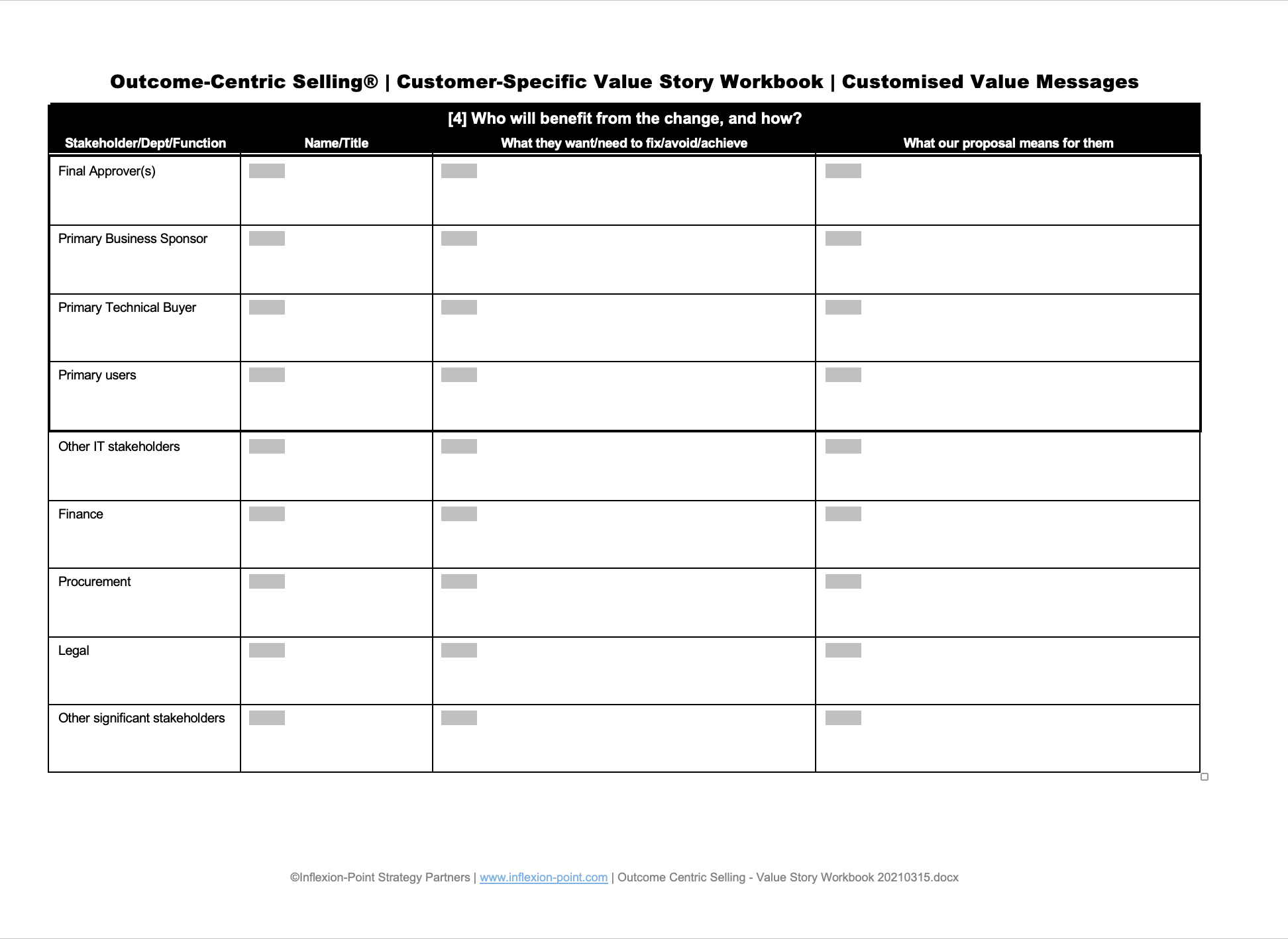
These tailored value messages must be both relevant to the particular stakeholder and be consistent with and supportive of the specific overall benefits we are promoting to the organisation as a whole in the “why us” part of their overall value story. Knowing what each of these stakeholders, departments or functions needs to fix, avoid or achieve will enable us to craft simple tailored value messages along the lines of “what this means to [STAKEHOLDER] is [BENEFIT]”.
Primary audiences
The primary audiences for these tailored value messages are the final approver(s), the primary business sponsor (typically the head of the department or function most affected by the issue) and the primary technical buyer (typically the CIO or IT director in the case of IT-based solutions) and the ultimate users of the solution.
Depending on the size and significance of the project, the final approver may be an individual (such as the CEO or ultimate budget holder) or a group (such as the board of directors).
Other significant audiences often include specialist IT functions (such as IT security), finance, procurement and legal, plus other departments or functions, some of which may be application specific (such as compliance in certain regulated industries).
A non-linear process
By the way, I don't mean to imply that this is a rigid, linear process or sequence. In fact, it's more usually an iterative process. To take one specific example, we often need to revisit elements of the "why now" question: the first time to understand the absolute pain/gain of the issue or project as part of "why change", and the second time to establish the relative priority of this project compared to all of the other potential projects that are jostling for the customer's attention.
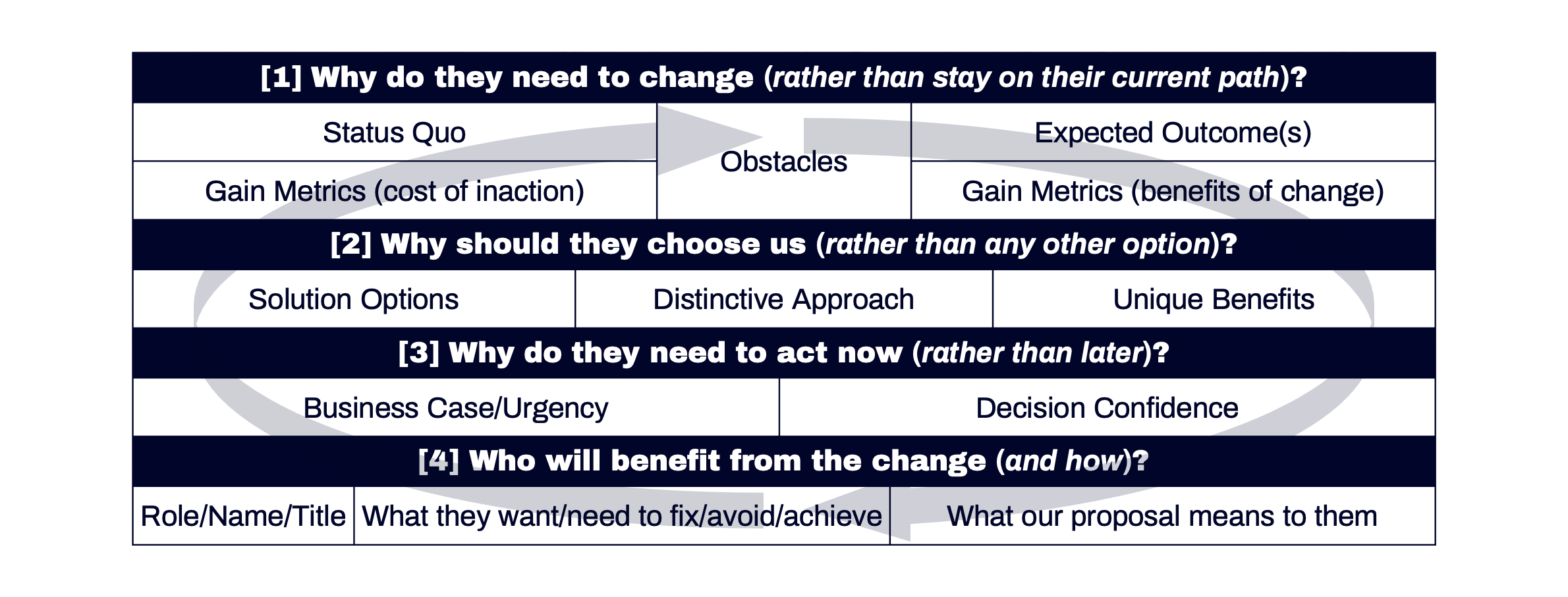
Embedding the customer’s value story into our proposal executive summary
The executive summary is always the most important element of any proposal. It is the one section that is likely to be read by everybody reviewing the proposal, and it will probably reach key contributors to the ultimate decision and approval process who may be unfamiliar with the details of the project (or even the reasons for its existence). We can expect some of them to question why the project is important, and why it needs to be implemented now, rather than later.
That’s why our executive summary must succinctly summarise why the customer needs to change, why they should choose us, why they need to act now, and how our proposal benefits each of the interested parties. The customer value story and tailored individual value message workbooks provide the essential raw material we need to craft that all-important executive summary. Here is a potential framework - it is intended to suggest the sequence in which key information is conveyed rather than a precise form of words:
- Thank the customer for the opportunity to propose
- [Their organisation] are wrestling with [the issues they have acknowledged to you, i.e., their status quo]. This is currently resulting in [immediate costs and consequences of inaction, i.e., their pain metrics] and if not resolved is likely to [future costs and consequences of inaction]
- Your objective is to [expected business outcome], which is projected to result in [projected benefits of change, i.e., their gain metrics], but your attempts to achieve this have been held back by [obstacles]
- Your current options include [identify their generic options]. We believe that our proposal stands out from others you may be considering because of [our distinctive approach, i.e., what sets us apart] and that this will enable you to [specific benefits to their organisation]
- The key elements of the business case are [summarise investment required, ROI case and so on], resulting in [projected initial business value] within [expected time to outcome] and a long-term payback of [long-term business value]
- We believe you can be confident in these expected outcomes because of [quote confidence-building evidence]
- For [primary users of the solution], our proposal offers [benefit to them]
- For [final approver(s)], our proposal offers [benefit to them]
- For [primary business sponsor], our proposal offers [benefit to them]
- For [primary technical buyer], our proposal offers [benefit to them]
- For [other key stakeholders/departments/functions], our proposal offers [benefit to them]
- Concluding remarks
Remember: if it is to have maximum impact, your proposal needs to not only sell your organisation and proposed solution (“why you?”), but also why they should change rather than stay on their current path, why they need to act now rather than later, and how the key stakeholders will benefit from your proposal.
Putting these principles into practice
If you have managed to stay with me thus far, if what I’ve been talking about resonates with you, and if you’d like to explore putting these principles into practice within your own sales organisation, we should talk.
We’ve developed simple tools and effective training programmes that are designed equip your salespeople to master the art and science of customer value storytelling. I hope to have the opportunity to tell you more.
About the Author
 Bob Apollo is a Fellow of the Association of Professional Sales, a founding contributor to the International Journal of Sales Transformation, a recognised Sales Futurist, an active member of the Sales Experts Channel, and the driving force behind Inflexion-Point Strategy Partners, the leading proponents of outcome-centric selling.
Bob Apollo is a Fellow of the Association of Professional Sales, a founding contributor to the International Journal of Sales Transformation, a recognised Sales Futurist, an active member of the Sales Experts Channel, and the driving force behind Inflexion-Point Strategy Partners, the leading proponents of outcome-centric selling.
Following a successful corporate career spanning start-ups, scale-ups and market leaders, Bob now works as a strategic advisor, mentor, trainer and coach to ambitious B2B sales organisations - teaching them how to differentiate themselves through their provably superior approach to achieving their customer's desired outcomes.


Comments